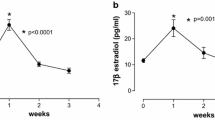Abstract
Sex steroid hormones contribute to the physiological regulation of bone turnover in males. To address this issue, we investigated serum estradiol (E2), total testosterone (T), and DHEAS concentrations, along with serum levels of carboxy-terminal telopeptide of type I collagen (sCTx), in a sample of 76 healthy men aged 23 to 87. The concentration of sCTx declined with age. Both T and DHEAS, at variance with E2, showed a significant age-related decline. T, DHEAS and sCTx significantly (p<0.01) correlated with each other. DHEAS and T were significantly associated after correcting for age (r=0.35, p=0.002) or body mass index (r=0.65, p<0.0001). DHEAS, but not T, significantly correlated with sCTx after correcting for age (r=0.26, p=0.026, and r=0.20, p=0.08, respectively). Stepwise multiple regression analysis showed that only DHEAS (but not T or E2) was a significant independent predictor of sCTx (p=0.0001). Our results show that adrenal androgens play a crucial role in regulating bone resorption in aging men.
Similar content being viewed by others
References
Slemenda CW, Longcope C, Zhou L, Hui SL, Peacock M, Johnston CC. Sex steroids and bone mass in older men. J Clin Invest 1997, 100: 1755–9.
Khosla S, Melton LJ III, Atkinson EJ, O’Fallon WM, Klee GG, Riggs BL. Relationship of serum sex steroid levels and bone turnover markers with bone mineral density in men and women: a key role for bioavailable estrogen. J Clin Endocrinol Metab 1998, 83: 2266–74.
Falahati-Nini A, Riggs BL, Atkinson EJ, O’Fallon WM, Eastell R, Khosla S. Relative contributions of testosterone and estrogen in regulating bone resorption and formation in normal elderly men. J Clin Invest 2000, 106: 1553–60.
Khosla S, Melton LJ III, Atkinson EJ, O’Fallon WM. Relationship of serum sex steroids levels to longitudinal changes in bone density in young versus elderly men. J Clin Endocrinol Metab 2001, 86: 3555–61.
Riggs BL, Khosla S, Melton LJ III. Sex steroids and the construction and conservation of the adult skeleton. Endocr Rev 2002, 23: 279–302.
Leder BZ, Le Blanc K, Schoenfeld DA, Eastell R, Finkelstein JS. Differential effects of androgens and estrogens on bone turnover in normal men. J Clin Endocrinol Metab 2003, 88: 204–10.
Gennari L, Merletti D, Martini G, et al. Longitudinal association between sex hormone levels, bone loss, and bone turnover in elderly men. J Clin Endocrinol Metab 2003, 88: 5327–33.
Szulc P, Garnero P, Munoz F, Marchand F, Delmas PD. Cross-sectional evaluation of bone metabolism in men. J Bone Miner Res 2001, 16: 1642–50.
Minisola S, Dionisi S, Pacitti MT, et al. Gender differences in serum markers of bone resorption in healthy subjects and patients with disorders affecting bone. Osteoporos Int 2002, 13: 171–5.
Oursler MJ, Pederson L, Fitzpatrick L, Riggs BL. Human giant cell tumors of bone (osteoclastomas) are estrogen target cells. Proc Natl Acad Sci USA 1994, 91: 5227–31.
Amin S, Zhang Y, Sawin CT, et al. Association of hypogonadism and estradiol levels with bone mineral density in elderly men from Framingham study. Ann Intern Med 2000, 133: 951–63.
Bilezikian JP, Morishima A, Bell J, Grumbach MM. Increased bone mass as a result of estrogen therapy in a man with aromatase deficiency. N Engl J Med 1998, 339: 599–603.
Khosla S, Melton LJ III, Riggs BL. Estrogen and the male skeleton. J Clin Endocrinol Metab 2002, 87: 1443–50.
Orwoll ES. Men, bone and estrogen: unresolved issues. Osteoporos Int 2003, 14: 93–8.
de Ronde W, Pols HA, van Leeuwen JP, de Jong FH. The importance of oestrogens in males. Clin Endocrinol (Oxf) 2003, 58: 529–42.
Vermeulen A. Androgens in aging male. J Clin Endocrinol Metab 1991, 73: 221–4.
Ferrini RL, Barrett-Connor E. Sex hormones and age: a cross-sectional study of testosterone and oestradiol and their bioavailable fractions in community-dwelling men. J Clin Endocrinol Metab 1998, 147: 750–4.
Orentreich N, Brind JL, Vogelman JH, Andrei R, Baldwin H. Long-term longitudinal measurements of plasma dehydroepiandrosterone sulfate in normal men. J Clin Endocrinol Metab 1992, 75: 1002–4.
Labrie F, Belanger A, Lun-The V, et al. DHEA and the intracrine formation of androgens and estrogens in peripheral target tisues: its role during aging. Steroids 1998, 63: 322–8.
Parker CR Jr. Dehydroepiandrosterone and dehydroepiandrosterone sulfate production in the human adrenal during development and aging. 1999, 64: 640–7.
Allolio B, Arlt W. DHEA treatment: myth or reality? Trends Endocrinol Metab 2002, 13: 288–94.
Guo CY, Weetman AP, Eastell R. Bone turnover and bone mineral density in patients with adrenal hyperplasia. Clin Endocrinol (Oxf) 1996, 45: 535–41.
Laughlin GA, Barrett-Connor E. Sexual dimorphism in the influence of advanced aging on adrenal hormone levels: the Rancho Bernardo Study. J Clin Endocrinol Metab 2000, 85: 3561–8.
Author information
Authors and Affiliations
Corresponding author
Rights and permissions
About this article
Cite this article
Carnevale, V., Scillitani, A., Vecci, E. et al. Dehydroepiandrosterone sulfate and bone resorption rates as reflected by serum levels of C-terminal telopeptide of type I collagen: A study in healthy men. J Endocrinol Invest 28, 102–105 (2005). https://doi.org/10.1007/BF03345350
Accepted:
Published:
Issue Date:
DOI: https://doi.org/10.1007/BF03345350




